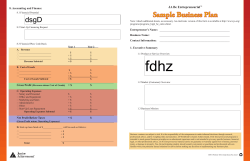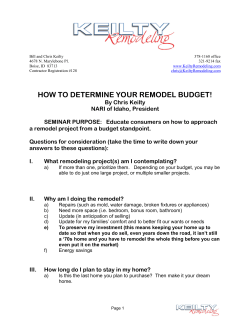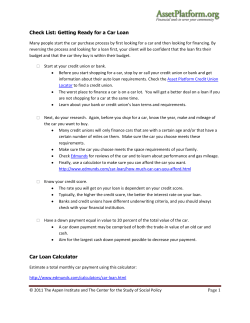
Business Plan Guide NYS S
NYS Small Business Development Center Farmingdale State College Business Plan Guide Small Business Development Center The SBDC is a program supported by the U.S. Small business administration and extended to the public on a non-discriminatory basis. SBA cannot endorse any products, opinions, or services of any external parties or activities. tel: (631) 420-2765 fax: (631) 370-8895 SBDC@farmingdale.edu www.farmingdale.edu/SBDC © 2002 Small Business Development Center, Farmingdale State College Revised 2009 Dear Entrepreneur: The New York State Small Business Development Center (SBDC) is a cooperative effort between the United States Small Business Administration (SBA) and the State of New York and is administered by the State University of New York (SUNY). The Farmingdale State Small Business Development Center has prepared this guide for entrepreneurs, such as yourself, to enable you to put your ideas about your business in writing. Just as a building needs a blueprint, a business needs a business plan. Preparing a business plan forces you to think through every aspect of your business and will serve as an assessment tool. As you work your way through the points outlined in this guide, you will need to reaffirm the viability of your ideas. As you grow as a business, a business plan will help you keep track of details and make sure the business is progressing as you intended. Both the Business Plan Guide and the one-on-one assistance provided by the Farmingdale State Small Business Development Center will allow you, the entrepreneur, to create an effective business plan. Good luck! This guide was written by Ritu S. Wackett, Business Advisor, SBDC Farmingdale State College ➥ The Business Plan – What Is It and Why Write It? The What A business plan is a written document that describes your business and how it will become successful. A business plan outlines the purpose and goals of the business and will illustrate how the business owner will realize these goals, including a detailed marketing strategy. A business plan will also contain a formal profit-and-loss projection and a cash flow analysis designed to show that if the business develops as expected, its will make money. The Why Just as a builder uses a blueprint to ensure that his building will be structurally sound, the process of creating and writing a “blueprint” for you business – the business plan – will help you determine whether or not your business will be strong from the start. Without writing a business plan, you leave far too many things to chance. Writing a well thought out and organized business plan dramatically increases your odds of succeeding as an entrepreneur. The benefits of a business plan include: • determining whether or not your business has a chance of making a profit • providing an estimate of your start-up costs, and how much you’ll need to invest or finance • convincing investors or lenders to fund your business • providing a revenue estimate ( by defining your market – who your customers will be – and the percentage of the market you can expect to reach) • helping your business make money from the start by devising an effective marketing strategy • helping you compete in the marketplace (through an analysis of what your competition lacks), and • anticipating potential problems so they can be averted before they become disasters. 1 ➥ If You Need to Raise Money If you need to raise funds for your venture, it goes without saying that you’ll need to write a solid, formal business plan. Business owners who want to borrow money or attract investors will be successful only if they have wellwritten, well-researched business plans. All of your potential lenders or investors will want to understand as much as possible about how your business will work before deciding whether to back it financially. If You Will Not Need to Borrow Money You will still need a business plan. A business plan isn’t just window dressing to attract potential investors or market your business to potential lenders. A solid business plan should sell you, the potential owner, on the financial viability and soundness of your business idea. Creating a business plan will force you to think about key issues before you start your business – such as what your start-up costs and marketing strategies are – and will help you determine whether or not your idea is feasible. A business plan, complete with a profit-and-loss statement and cash-flow analysis, will allow you to tinker with your idea and improve it before you start. Or, taking an honest look at the numbers may make it clear that hoped-for profits are unlikely to materialize. In this case, one of the most important purposes of writing a good business plan is to talk yourself out of starting a business that is doomed to fail. 2 ➥ Outline of a Business Plan • Cover Sheet • Executive Summary • Table of Contents • Statement of Purpose • Business Description • Products and Services • Market Analysis a. Customers b. Competition c. Marketing Strategy • Management • Operations • Financial Plan • Appendices 3 ➥ Cover Sheet The cover sheet provides identifying information about you and your business. It should have the words “Business Plan” on it and should also include: • Your name and business name • Company logo • Address • Telephone number • Fax Number • Email Address • Web Address (URL) The date the plan was finalized and submitted to the recipient should also be included on this page. Executive Summary The executive summary may be the most important part of your business plan. While it is the first part of the plan, it should be written last. It should concisely explain your business’ current status; describe its products and services and their benefits to your customers; provide an overview of your venture’s objectives, market prospects and financial forecasts; and if you are using the plan to raise capital, explain how the money will be used, and the expected payback terms. Table of Contents All pages of your business plan should be correctly numbered and the table of contents should include page numbers. Additionally, include a list of headings for the major sections (as described here) as well as any subsections. This will provide the reader with a quick overview of the contents of your plan and allow them to quickly access the particular sections that may be of interest to them. 4 ➥ Statement of Purpose This is a brief statement of the business plan’s objectives. In general, what is the purpose of the plan? Is it to be used as an operating guide or a financing proposal? If it is to be used as an operating guide, then the statement is rather simple: “This plan will be an operating and policy guide of XYZ Company.” In the case of the financing proposal, a few questions should be addressed: • How much money is needed? • What will the money be used for? • How will the funds benefit the business? • Why does this loan or investment make business sense? • How will the funds be repaid? Business Description Begin with your mission statement – a one or two sentence description of the purpose of the business and to whom the product or service is targeted. The business description should also include the following: • Legalities – business form: proprietorship, partnership, corporation (S or C), LLC or LLP. Be sure to include when and by whom the business was founded. • Sector – retail, service, wholesale, manufacturing, construction or agriculture. • What your product or service is. • Is the business new, a takeover, an expansion, a franchise? • Why your business will be profitable. What are the growth opportunities? • When will the business be open? • Your experience in the business. You need not provide a complete resume here, that will go into another section, but describe the unique skills and qualities you have that will promote success in the industry. If your business is a start-up your experience should be emphasized since there is no company history. 5 ➥ Products and Services Describe each of the products or services your business offers. Go into as much detail as necessary in order for the reader to get an understanding for what the enterprise will be. Make it interesting. It is important to point out how your particular enterprise is different from other businesses. Indicate the stage of development your product is at and whether prototypes, working models or finished production units are available. Additionally, describe product distribution and product packaging. Describe any patents or trademarks you may have applied for, or any licensing agreements or other legal contracts that may provide protection for your product or service. Are there any regulatory or government-approved standards or requirements that your products must meet? How and when do you plan to obtain this certification? Market Analysis Customers It is important to be specific when describing the customers who will define your target market. This description defines the characteristics of the people the endeavor wants to sell to. If yours is an existing business list current key customers and any sales trends or patterns. If your business is new look at the demographics of the potential customers. For individual customers, some factors to consider: • Location • Age • Gender • Age and Ethnic Group • Hobbies • Lifestyle • Education • Social Class • Occupation 6 ➥ • Income Level • Family Life Cycle For business customers some factors to consider: • Sector • Location • Structure • Sales level • Special requirements • Distribution Classification • Number of Employees Competition Present a short discussion of at least three of your business’ primary competitors. Each assessment should answer the following questions regarding the competition (Answer these questions with the positive aspects of your business, rather than negatively attacking the competition): • How will your operation be better than theirs? • How is their business: Steady? Increasing? Decreasing? Why? • How are their operations similar and dissimilar to yours? • What are their strengths and/or weaknesses? • What have you learned from observing their operations? Their advertising? • How do you plan to keep an eye on the competition in the future? Marketing Strategy The marketing strategy will detail how you will promote your product or service in the marketplace in order to obtain a profitable share of the entire marketplace. The marketing strategy should describe what is to be done, when it is to be done, and who will do it insofar as your sales strategy, advertising and promotion plans, pricing policy, and channels of distribution are concerned. Factors to consider: • Pricing – Is your price within the range of your competitors? • Sales and Distribution – If distributors are to be used, describe how they will be attracted, compensated, and what geographic areas will be covered. If a direct sales force will be used, describe how it will be organized and controlled. 7 ➥ Financial Plan (Formats are found in the appendix.) To effectively manage your finances, plan a sound, realistic budget by determining the actual amount of money needed to open your business (start-up costs). The first step to building a sound financial plan is to devise a start-up budget. Your start-up budget will usually include such one-time only costs as major equipment, utility deposits, down payments, security deposits, etc… A start up budget should allow for these expenses: • Personnel (costs prior to opening) • Occupancy (lease, rent or mortgage) • Legal/Professional Fees • Equipment • Supplies • Salary/Wages • Income • Utilities • Payroll Expenses • Internet • Licenses/Permits • Insurance • Advertising/Promotions The operating budget is prepared when you are actually ready to open for business. The operating budget will reflect your priorities in terms of how money will be spent, the expenses you will incur and how you will meet those expenses. Your operating budget should also include money to cover the first three to six months of operation. It should cover the following expenses: • Personnel • Lease/Rent/Mortgage • Loan payments • Legal fees • Accounting • Supplies 9 ➥ • Salaries/Wages • Dues/Subscriptions/Fees • Repairs/Maintenance • Insurance • Advertising/Promotions • Depreciation • Payroll Expenses • Internet • Payroll taxes • Travel • Entertainment • Miscellaneous The financial plan should also describe the type of financing you are seeking, the amount of money you are looking for, how you plan to use these funds (itemized) and the preferred terms for repayment. The financial plan will be the tool prospective investors, bankers, and even you will use in order to determine the feasibility of the opportunity you are presenting. If the business is existing, it should illustrate the current financial status of your business and represent your best estimate of its future operation. If the business is new, a projection will suffice. The results presented should be both realistic and attainable. The financial forecasts should come in the form of three-year cash flow and balance sheet statements. 10 ➥ Appendices The appendices are intended to explain, support and supplement the material in the narrative and financial projections of your business plan. Each piece of material is placed in its own appendix at the back of your plan. Types of material that are includes are: • Resumes of management team • Your past three years of tax returns (business and personal for existing businesses, personal only, for start-ups) • Interim income statement and balance sheet • Copies of existing loans or notes. • Personal income statement • Copies of legal documents such as leases, franchise and licensing agreements, contracts, licenses, patent or trademark registrations, articles of incorporation or organization, or DBA certificate • Copies of potential contracts • Letters of reference Appendix to the Business Plan Guide Cash Flow Projection Format • Year 1 • Year 2 • Year 3 Pro-Forma Income Statement Pro-Forma Balance Sheet 11 Other Income Sales CASH FLOW PROJECTION Cash In-Flows Total In-Flows Month Cost of Goods Sold Rent/Mortgage Owner’s Salary Other Salaries Payroll Taxes Advertising & Promotion Utilities Loan Payments (current) Loan Payments (previous) Telephone Office Expense Dues & Subscriptions Accounting Insurance Professional fees Internet Repairs & Maintenance Licenses & Permits Travel & Entertainment Legal fees Bank charges Miscellaneous Cash Out-Flows Total Out-Flows Net Cash Flow Beginning Cash Balance Ending Cash Balance 1 2 3 4 5 Year One 6 7 8 9 10 11 12 Total CASH FLOW PROJECTION Year 2 Quarter Cash In-Flows Sales Other Income Total In-Flows Cash Out-Flows Cost of Goods Sold Rent/Mortgage Owner’s Salary Other Salaries Payroll Taxes Advertising & Promotion Utilities Loan Payments (current) Loan Payments (previous) Telephone Office Expense Dues & Subscriptions Accounting Insurance Professional fees Internet Repairs & Maintenance Licenses & Permits Travel & Entertainment Legal fees Bank charges Miscellaneous Total Out-Flows Net Cash Flow Beginning Cash Balance Ending Cash Balance 1 2 3 4 Total CASH FLOW PROJECTION Year 3 Quarter Cash In-Flows Sales Other Income Total In-Flows Cash Out-Flows Cost of Goods Sold Rent/Mortgage Owner’s Salary Other Salaries Payroll Taxes Advertising & Promotion Utilities Loan Payments (current) Loan Payments (previous) Telephone Office Expense Dues & Subscriptions Accounting Insurance Professional fees Internet Repairs & Maintenance Licenses & Permits Travel & Entertainment Legal fees Bank charges Miscellaneous Total Out-Flows Net Cash Flow Beginning Cash Balance Ending Cash Balance 1 2 3 4 Total Pro-Forma Income Statement Year Sales Other Income Gross Profit Operating Expenses Cost of Goods Sold Rent/Mortgage Owner’s Salary Other Salaries Payroll Taxes Advertising & Promotion Utilities Telephone Office Expense Dues and Subscriptions Accounting Insurance Professional fees Internet Repairs & Maintenance Licenses & Permits Travel & Enertainment Legal fees Bank Charges Miscellaneous Depreciation Interest Operating Expenses Net Income 1 2 3 Pro-Forma Balance Sheet (Opening Day of Business) ASSETS Cash Accounts Receivable Inventories Prepaid Expense Other Current Assets ______________________ ______________________ ______________________ ______________________ ______________________ TOTAL CURRENT ASSETS FIXED ASSETS Land Leasehold Improvements Equipment Vehicles Other Fixed Assets ______________________ ______________________ ______________________ ______________________ ______________________ Subtotal Fixed Assets ______________________ Less: Accumulated Depreciation ______________________ TOTAL FIXED ASSETS TOTAL ASSETS CURRENT LIABILITIES Accounts Payable Current Portion of Long-Term Debt Accrued Expenses Other Current Liabilities ______________________ ______________________ ______________________ ______________________ TOTAL CURRENT LIABILITIES LONG-TERM DEBT, net of current portion OWNER’S EQUITY Paid-In Capital Retained Earnings TOTAL OWNER’S EQUITY TOTAL LIABILITIES & OWNER’S EQUITY ______________________ ______________________
© Copyright 2025





















